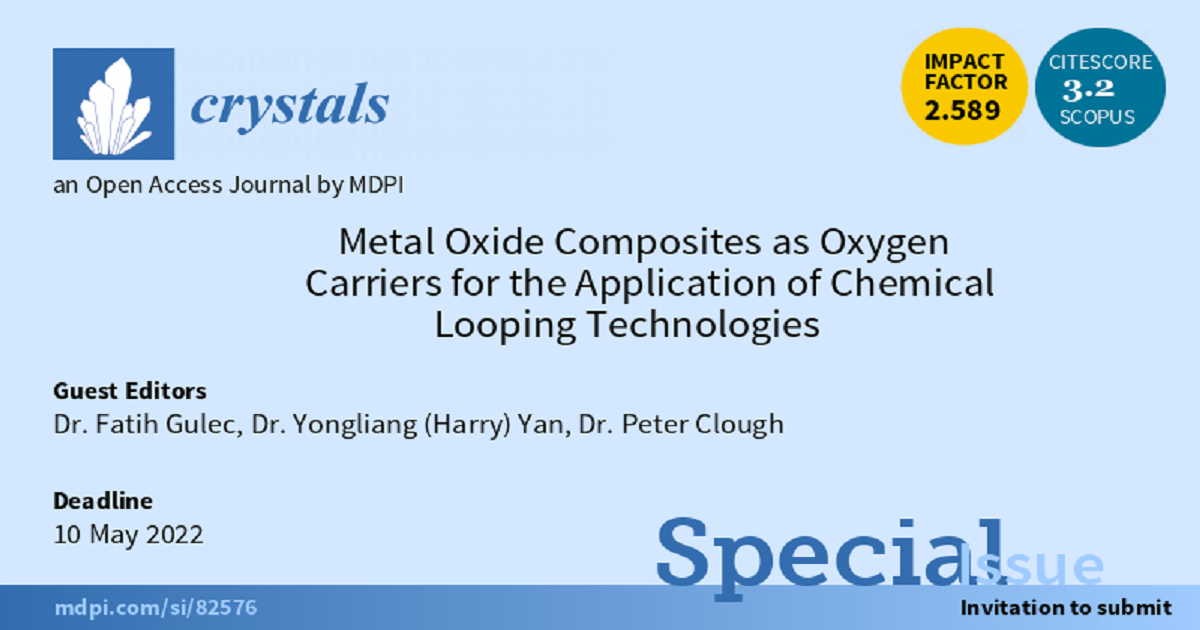Metal Oxide Composites as Oxygen Carriers for the Application of Chemical Looping Technologies
A special issue of Crystals (ISSN 2073-4352). This special issue belongs to the section "Crystalline Metals and Alloys".
Deadline for manuscript submissions: closed (10 May 2022) | Viewed by 5269

Special Issue Editors
Interests: porous materials; metal oxide composites; oxygen carriers; chemical looping technologies; phase transitions; heterogeneous catalysis; zeolites; silicates; biomass processing technologies
Special Issues, Collections and Topics in MDPI journals
Interests: high-temperature solid-looping systems for carbon capture; thermochemical energy storage and low-carbon hydrogen production; harnessing the power of machine learning techniques for energy process systems and material developments
Interests: hydrogen; carbon capture and storage; sorption enhanced steam reforming; machine learning
Special Issues, Collections and Topics in MDPI journals
Special Issue Information
Dear Colleagues,
Chemical looping technologies have emerged as attractive processes for the applications of clean energy and syngas production. Thanks to its dual-fluidised bed reactor system, air never mixes with the fuel, which inherently separates CO2 from the other flue gas components. Metal oxides, such as Cu-, Co-, Mn-, Ni-, Fe-based and their composites, transfer the oxygen between these two interconnected reactors as oxygen carriers and play a crucial role in the commercialisation of the chemical looping technologies. Successful applications of these technologies will require an extensive understanding of metal oxide composites, such as large-scale synthesis procedures, reactivity, surface interactions with additives, phase and structural changes, interaction with fuels, and long-term stability and reliability. Additionally, both modelling and experimental studies on the application of composite metal oxides could be an effective way to identify the candidates for chemical looping technologies. We invite researchers to contribute to the Special Issue on “Metal Oxide Composites as Oxygen Carriers for the Application of Chemical Looping Technologies”, which is intended to serve as a forum covering broad aspects of the science, technology, and applications of metal oxide composites as oxygen carriers in chemical looping technologies.
The potential topics include, but are not limited to:
- Synthesis of novel metal oxide composites as oxygen carriers;
- Advanced material characterisation techniques on oxygen carriers;
- Phase and structural changes of oxygen carriers in chemical looping applications;
- Kinetics of oxygen carriers under chemical looping applications;
- Computational modelling of surface interactions of oxygen carriers with additives;
- Quantitative structure property relationships and predictions of new oxygen carriers.
Dr. Fatih Gulec
Dr. Yongliang (Harry) Yan
Dr. Peter Clough
Guest Editors
Manuscript Submission Information
Manuscripts should be submitted online at www.mdpi.com by registering and logging in to this website. Once you are registered, click here to go to the submission form. Manuscripts can be submitted until the deadline. All submissions that pass pre-check are peer-reviewed. Accepted papers will be published continuously in the journal (as soon as accepted) and will be listed together on the special issue website. Research articles, review articles as well as short communications are invited. For planned papers, a title and short abstract (about 100 words) can be sent to the Editorial Office for announcement on this website.
Submitted manuscripts should not have been published previously, nor be under consideration for publication elsewhere (except conference proceedings papers). All manuscripts are thoroughly refereed through a single-blind peer-review process. A guide for authors and other relevant information for submission of manuscripts is available on the Instructions for Authors page. Crystals is an international peer-reviewed open access monthly journal published by MDPI.
Please visit the Instructions for Authors page before submitting a manuscript. The Article Processing Charge (APC) for publication in this open access journal is 2100 CHF (Swiss Francs). Submitted papers should be well formatted and use good English. Authors may use MDPI's English editing service prior to publication or during author revisions.
Keywords
- metal oxide composites
- material characterisation
- chemical looping combustion
- chemical looping gasification
- chemical looping hydrogen production
- chemical looping selective oxidation
- chemical looping air separation
- chemical looping–thermochemical energy storages
- new chemical looping applications
Benefits of Publishing in a Special Issue
- Ease of navigation: Grouping papers by topic helps scholars navigate broad scope journals more efficiently.
- Greater discoverability: Special Issues support the reach and impact of scientific research. Articles in Special Issues are more discoverable and cited more frequently.
- Expansion of research network: Special Issues facilitate connections among authors, fostering scientific collaborations.
- External promotion: Articles in Special Issues are often promoted through the journal's social media, increasing their visibility.
- e-Book format: Special Issues with more than 10 articles can be published as dedicated e-books, ensuring wide and rapid dissemination.
Further information on MDPI's Special Issue polices can be found here.







